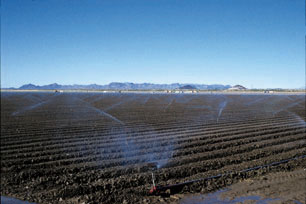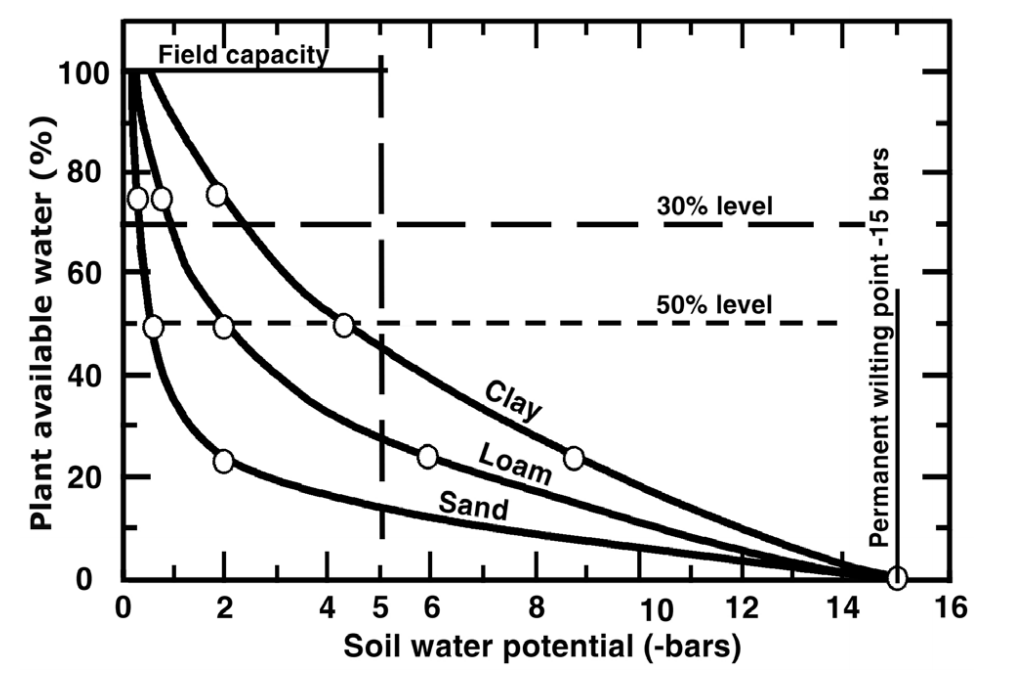Generally, 38 to 50 inches of water per acre are required to produce a desirable lettuce crop, but this varies dramatically with soil type, slope of field, temperatures and planting window. Irrigation water is delivered via canals from the Colorado River, or from deep wells, in Yuma County.
There are two distinct irrigation stages in the low desert of Arizona. The first irrigation stage involves seed germination and stand establishment. During the 'Empire' slot in late August and early September, seed bed temperatures may exceed 140 øF. Under these conditions, impact sprinklers are essential to not only provide water, but also to reduce the temperature of the seed bed though evaporative cooling (Fig. 4).

Figure 4. Sprinklers are commonly used to germinate lettuce seed when temperatures are hot.
When used, sprinkler pipe is placed in the field immediately after planting. The pipes are typically 3 inches in diameter and are spaced 40 ft apart. Each pipe contains 12 inch risers spaced 30 ft apart, mounted with a 4 inch long impact sprinkler head. In Yuma, Weather Tec 10-10 or Rainbird 14-VH sprinkler heads are most commonly used. The sprinkler heads are typically equipped with a 5/64 inch orifice to disperse the water. Water pressure is maintained at 60 to 80 psi, depending on the temperature and evaporation rate. Worn orifices or inadequate water pressure may result in excessively large water droplet sizes that may wash out seed planted in the immediate vicinity of the sprinkler head. During periods of high temperatures, growers may opt to use impact sprinkler heads with a 23° v-shaped wedge drive water diffuser. The wedge drive reduces droplet size, increases evaporative cooling and speeds the sprinkler's rotation. Under hot conditions, sprinklers are continuously kept running unless the field is in jeopardy of becoming super saturated or anaerobic, in which case every other sprinkler pipe may be turned off and/or all turned off during the night and morning.
Under cooler conditions, evaporative cooling may not be an important consideration, but sprinklers are often used to deliver uniform moisture to maximize stand uniformity. Under these conditions, sprinklers are turned on as needed to maintain a moist seed bed. When using sprinklers, the water source must be low (800 parts per million {ppm} or less) in sodium and chloride salts. After stand establishment, the field is allowed to dry and the sprinkler pipes removed.
In addition to using sprinklers for stand establishment, once daily temperatures cool to less than 85° F, lettuce may be germinated using furrow irrigation. For effective germination, beds should be moistened thoroughly but not to the point that they become super saturated and anaerobic. The field is generally maintained in a flooded condition until the lettuce has uniformly emerged.
The second irrigation stage involves furrow irrigation for crop maintenance following stand establishment. Usually an irrigation is made to soften the soil prior to thinning and cultivation. Afterwards, adequate moisture should be maintained throughout plant development.
During the second irrigation stage, the furrows are typically filled within approximately 1 to 2 inches from the top of the beds and then the water is cut off. Care is taken to avoid saturating the middle of the bed to the point where the top of the bed becomes wet or "blackened." Otherwise, the potential of developing infections of bottom rot, Rhizoctonia solani, or leaf drop, Sclerotinia spp., will be greatly enhanced. During harvest, an irrigation may be necessary between cuttings if multiple harvests are necessary or profitable.

When the soil profile is full of water, reaching what is called field capacity (FC), the profile is said to be at 100% moisture content or at about 0.1 bars of tension. Tension is a measurement of how tightly the soil particles hold onto water molecules in the soil: the tighter the hold, the higher the tension. At FC, with a tension of only 0.1 bars, the water is not being held tightly and it is easy for plants to extract water from the soil. As the water is depleted by the plants, the tension in the soil increases. Figure 1 shows three typical curves for sand, clay and loam soils. As Fig. 1 shows, the plants will use the water in the soil until the moisture level goes to the permanent wilting point (PWP). Once the soil dries down to the PWP, plants can no longer extract water from the soil and the plants die. Although there is still some moisture in the soil below the PWP, this water is held so tightly by the soil particles that it cannot be extracted by the plant roots. The PWP occurs at different moisture levels depending on the plant and soil type. Some plants, which are adapted to arid conditions, can survive with very little moisture in the soil. With most agronomic crops, PWP occurs when the tension in the soil is at 15 bars. This means that the soil is holding on very tightly to the water in its pores. In order for plants to use this water, they must create a suction greater than 15 bars. For most commercial crops, this is not possible. At 15 bars, most plants begin to die. The difference between field capacity and PWP is called the plant available water (PAW).
Irrigation targets are usually set as a percent depletion of the PAW. This depletion level is referred to as Management Allowable Depletion (MAD). The bulk of irrigation research recommends irrigating row crops such as grain or cotton when the MAD approaches 50%. For vegetable crops, the MAD is usually set at 40% or less, because they are more sensitive to water stress. These defined amounts insure that water stress will not be so severe as to cause any appreciable yield losses. Careful monitoring of the PAW needs to be done throughout the season so that the appropriate point of irrigation can be anticipated.